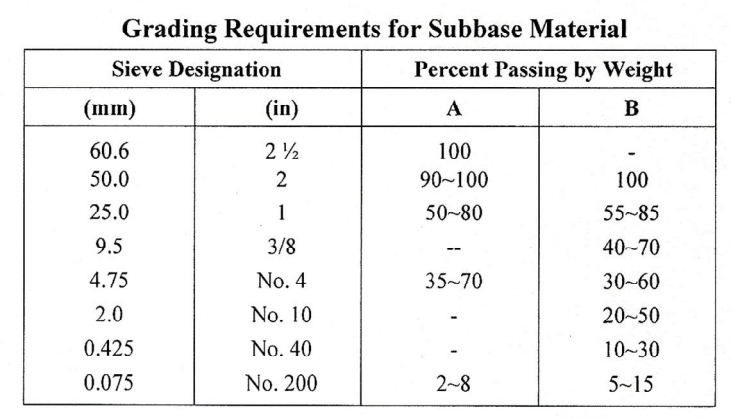Table of Contents
Standard Followed
ASTM D 4791
Objective
This test is performed on coarse aggregates and is intended to determine the shape of aggregates i.e., rounded, angular, flaky, or elongated. In addition, the percentage of flaky or elongated particles in an aggregate sample can be determined and discarded.
Related Theory
Rounded Aggregates:
Rounded aggregate particles have no edges. Instead, they have smoothly curved sides. These particles are preferred for the construction of rigid pavements. This is because they offer less inter-particle friction and enhance the workability of the concrete mix.
- Source: Rounded aggregates are generally found in the vicinity of a river body in the form of river gravel.

Angular Aggregates:
Angular particles possess sharp edges and rough-textured surfaces, with relatively plane sides. The angularity of these particles proves advantageous for particle inter-locking, making their use the best choice for a granular base coarse construction, conferring stability to the pavement.
- Source: Crushed rocks are usually angular in shape.

Flaky Particles:
A flaky particle is one whose least dimension (i.e., its thickness) is less than 0.6 times the mean size of the particle. These particles are a source of frailty for an aggregate mix and therefore, they must be identified and discarded.
However, practically, an aggregate sample cannot be devoid of such particles. Therefore, the standard has levied some restrictions on the maximum acceptable percentage of flaky particles in an aggregate mix.
Quantitatively, a maximum limit of 30% flaky particles is imposed by the standard and is regarded as acceptable. Nevertheless, a sample comprising flaky particles in a percentage greater than 30% is not qualified for the intended use.

Flakiness Index: It is a fractional value that represents the percentage by weight of flaky particles in an aggregate mix. It is mathematically calculated as the ratio of the weight of flaky particles to the total sample weight.

Elongated Particles:
These particles have their lengths dominating the other two dimensions considerably. As an estimate, the particle length is greater than 1.8 times the mean particle size. These particles are also a source of weakness for an aggregate sample. However, as per the standard’s implications, a maximum percentage of 45% elongated particles in the mix is tolerable.

Elongation Index: It represents the weight of elongated particles as a percentage of the total sample’s weight. Mathematically,

Significance of determination of flakiness and elongation index
Determination of the flakiness and elongation index of an aggregate sample is important for the following reasons:
- The degree of packing or inter-locking of an aggregate sample depends on the shape of the particles in the mix, therefore, too many flaky or elongated particles can prove an obstacle in achieving the desired packing of aggregates.
- Flaky and elongated particles tend to lower the workability of concrete mixes. This is because these particles have a very large value of the surface area to volume ratio.
- These particles are inherently friable when subjected to heavy loading. Therefore, these are not desirable when preparing concrete mixes for structures that have to bear substantial loads.
Test Limitations
The flakiness and elongation index test cannot be performed on aggregates having a size smaller than 6.3mm or 1/4 in.
Apparatus
- Flakiness index gauge also called thickness gauge
- Elongation index gauge also called length gauge
- Coarse aggregate sample
- Weighing balance

Fig.: Flakiness Index Gauge

Fig.: Elongation Index Gauge
Test Procedure
Determination of Flakiness Index
- Sieve the aggregate particles and divide them into groups such that the particle sizes in each group are closely related, for example, 2.5-2 in., 1.5-0.75 in., etc. The intent of dividing the sample into factions is to find the individual flakiness index corresponding to a particular size range.
- Weigh each group and record the weights.
- For each group, take individual aggregate particles and pass them through the thickness gauge. In this attempt, make sure the particles are not compelled to pass a particular opening of the thickness gauge. This is because doing this may break very weak particles and give misleading results. It is to be kept in mind that the particles that pass through a particular slot of thickness gauge are the flaky ones and are a source of weakness for the sample.
- Weigh the fraction of aggregates in each group that passes through the thickness gauge.
- Determine the individual flakiness index of each huddle by dividing the weight of flaky particles in each group to the total weight of aggregates in the corresponding group. Cumulate the percentage values to determine the flakiness index of the entire aggregate sample.
Determination of Elongation Index
- Sieve the aggregate sample into groups of closely limited particle sizes, e.g. 2.5-2 in., 0.5-0.375 in., etc.
- Pass each aggregate particle separately through the elongation gauge and weight the fraction passing through the gauge. It is important to note that particles that are not able to pass through any slot or opening on the length gauge are the elongated ones.
- Determine the individual elongation index of each huddle by dividing the weight of elongated particles in each group to the total weight in the corresponding group.
- Cumulate the individual elongation indices of the groups to find the elongation index of the aggregate sample.
Observations and Calculations
Weight of Aggregate Sample =
Determination of Flakiness Index
| Passing Sieve # | Retaining
Sieve # |
Weight Retained (g) |
Weight of Flaky Particles
(g) |
Individual Flakiness Index | Weighted Flakiness Index (%) |
| 1.5 in. | 1 in. | ||||
| 1 in. | 3/4 in. | ||||
| 3/4 in. | 1/2 in. | ||||
| 1/2 in. | 3/8 in. | ||||
| 3/8 in. | 1/4 in. | ||||
| Ʃ = | Ʃ = |
Formulae Used:

Determination of Elongation Index
| Passing Sieve # | Retaining
Sieve # |
Weight Retained
(g) |
Weight of Elongated Particles
(g) |
Individual Elongation Index | Weighted Elongation Index
(%) |
| 1.5 in. | 1 in. | ||||
| 1 in. | 3/4 in. | ||||
| 3/4 in. | 1/2 in. | ||||
| 1/2 in. | 3/8 in. | ||||
| 3/8 in. | 1/4 in. | ||||
| Ʃ = | Ʃ = |
Formulae Used:

Results
For the aggregate sample;
- Flakiness Index (%) =
- Elongation Index (%) =
If the index values are less than the limiting values specified by the standard, the sample marked qualified for the intended use.
The sample gradation curve can also be plotted using the sieve analysis data and the conformance of the sample’s gradation with the limiting gradation curves provided by the standard can also be assessed. However, the grading requirements of aggregates to be used in the base course and sub-base course are separately defined, considering the amount of load each course has to bear.


Source: AASHTO’s Guidelines
If the sample’s gradation curve lies between the limiting curves plotted against the specified values given in the table, the sample is well-graded. If the sample’s distribution curve lies outside the extremities defined by the standard, it is said to be poorly graded.
Test Precautions
- Do not force any particle through the slots on the thickness or length gauge. Doing this may distort or break the particles, giving inaccurate results.
- The aggregate quantity taken for the test should be ample so that for each sieved huddle, enough aggregate quantity is available for the test.
Discussion
The significance of finding the individual flakiness index is that it helps in figuring out the particle size range that is troublesome for the aggregate sample. This means that the results can easily be amended if we get rid of flaky particles in the determined range.




